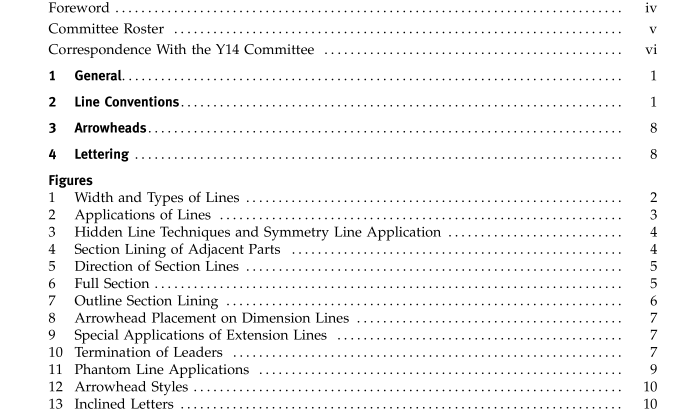ASME Y14.2-2008 pdf free download.Line Conventions and Lettering Engineering Drawing and Related Documentation Practices
1.1 Scope This Standard establishes the line and lettering prac- tices for use in the preparation of drawings, including the recognition of the requirements for computer aided design (CAD) and manually prepared drawings. 1.2 Units of Measurement All dimensions used in this Standard are in millime- ters, except in Mandatory Appendix
1.3 Applicable Documents The following revisions of American National Standards form a part of this Standard to the extent specified herein. A more recent revision may be used, provided there is no conflict with the text of this Standard. In the event of a conflict between the text of this Standard and the references cited herein, the text of this Standard shall take precedence. ASME Y14.3M-2003, Multiview and Sectional View Drawings ASME Y14.5M-1994, Dimensioning and Tolerancing Publisher: The American Society of Mechanical Engineers (ASME), Three Park Avenue, New York, NY 10016-5990; Order Dept: 22 Law Drive, P. O. Box 2900, Fairfield, NJ 07007-2900 2 LINE CONVENTIONS Line conventions describe the size, construction, and application of the various lines used in making draw- ings. Paragraphs 2.1 through 2.14 identify the type and style of lines for use on drawings.
2.1 Line Widths Two widths of lines should be used on drawings (see Fig. 1). The thin line width shall be 0.3 mm minimum. The thick line width shall be 0.6 mm minimum. These approximate line widths are intended to differentiate between thick and thin lines and are not values for con- trol of acceptance or rejection of drawings. All lines of the same type shall be uniform throughout the drawing. The ratio of line widths should be approximately two- to-one (2:1).
2.2 Line Spacing Spacing between parallel lines may be exaggerated to a maximum of 3 mm, so there is no fill-in when the drawing is reproduced.
2.3 Visible Lines Visible lines are continuous and shall be used for rep- resenting visible edges or contours of objects (see Figs. 1 and 2).
2.4 Projection Line Projection lines are lines used to indicate the line of sight between two successive orthographic views.
2.5 Hidden Lines Hidden lines are used to represent hidden edges and contours. They consist of short evenly spaced dashes and are used to show the hidden features of an object (see Figs. 1 and 2). The length of the dashes may vary slightly in relation to the scale of the view. Hidden lines should begin and end with a dash in contact with the visible or hidden line from which they start or end, except when such a dash would form a continuation of a visible line or when a CAD system has limitations that cannot comply with these requirements. Dashes should join at corners, and arcs should start with dashes at tangent points (see Fig. 3). When features located behind transparent materials are depicted, they shall be treated as concealed features and shown with hidden lines. Hidden lines should be omitted when their use is not required for the clarity of the drawing.
2.6 Section Lines Section lines are used to show surfaces cutby a cutting plane. They are drawn as a pattern of straight, equally spaced, parallel lines used to indicate the cut surfaces of an object in section views (see Figs. 1 and 2).
2.6.1 General Principles. Cut surfaces of sectional views may be identified by using section lines. Section lines are optional and may be used when necessary to distinguish individual components of an assembly or to distinguish different surface levels of a full or partial section through a part (see ASME Y14.3M). Lettering should not be placed in section areas. How- ever when it is unavoidable, the section lines shall be omitted in the area for the lettering (see Fig. 4).ASME Y14.2 pdf download.ASME Y14.2-2008 pdf free download
